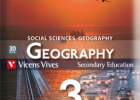Migration
The ever-changing nature of the world's population is affected by factors such as the birth rate, mortality rate and, above all, migration (the movement of people from one place to another). Today, migration patterns are closely linked to globalisation. Migration trends are mainly determined by economic opportunities and the search for a better life, either in another country, or within the same one. [...]
Esta secuencia contiene:
-
11 actividades
-
101 recursos
-
Idioma:
- Inglés
-
Formato:
Interactivo
Secuencia didáctica
-
Didactic objectives Identify the factors that affect the evolution of the population. Analyse the economic factors and historical reasons behind the migration phenomenon in the context of globalisation. [...]
-
1. Migration today Every year, thousands of people abandon their homes and move to another place in the same country or abroad in search of a better life. [...]
-
The ever-changing nature of the world's population is affected by factors such as the birth rate, mortality rate and, above all, migration (the movement of people from one place to another). [...]
-
As you have learned previously, the population of a place varies according to natural increase and migration. Migration includes the number of people that move to a place (immigrants) and the people that move away from a place (emigrants). [...]
-
1.1. The age of migration Every year, many thousands of people abandon their place of origin and move to another place, in search of a better life. They may move to a different place within the same country or abroad. [...]
-
2.1. South-North migration Economic globalisation has created great inequalities between LEDCs (sometimes known as 'the South') and MEDCs ('the North'). This causes massive migration from poor areas to wealthy areas of the world. [...]
-
3.1. Economic and social effects Economic effects International migration has economic repercussions. A lot of immigrant workers send home a portion of the money they earn in the receiving country. [...]
-
4.1. Spain: a country of emigrants From the second half of the 19th century onwards, Spain became a country of emigrants, and maintained a negative net migration rate until the last decade of the 20th century. [...]
-
5.1. Immigration today Towards the end of the 20th century, Spain became a receiving country as the number of immigrants increased significantly. [...]
-
The ever-changing nature of the world's population is affected by factors such as the birth rate, mortality rate and, above all, migration (the movement of people from one place to another). [...]
-
The ever-changing nature of the world's population is affected by factors such as the birth rate, mortality rate and, above all, migration (the movement of people from one place to another). [...]
Cursos y asignaturas
-
14 años:
- Cultura clásica
- Religión
-
15 años:
- Religión
- Cultura clásica
-
Aún no hay comentarios, ¡comparte tu opinión! Inicia sesión o Únete a Tiching para poder comentar
La licencia digital es una autorización que permite utilizar un recurso digital de acuerdo con las condiciones legales de dicho recurso. El código que recibas una vez la hayas comprado te permitirá acceder al recurso educativo digital elegido.
Puedes consultar más información en nuestra página de ayuda.















































































































¿Dónde quieres compartirlo?
¿Quieres copiar el enlace?